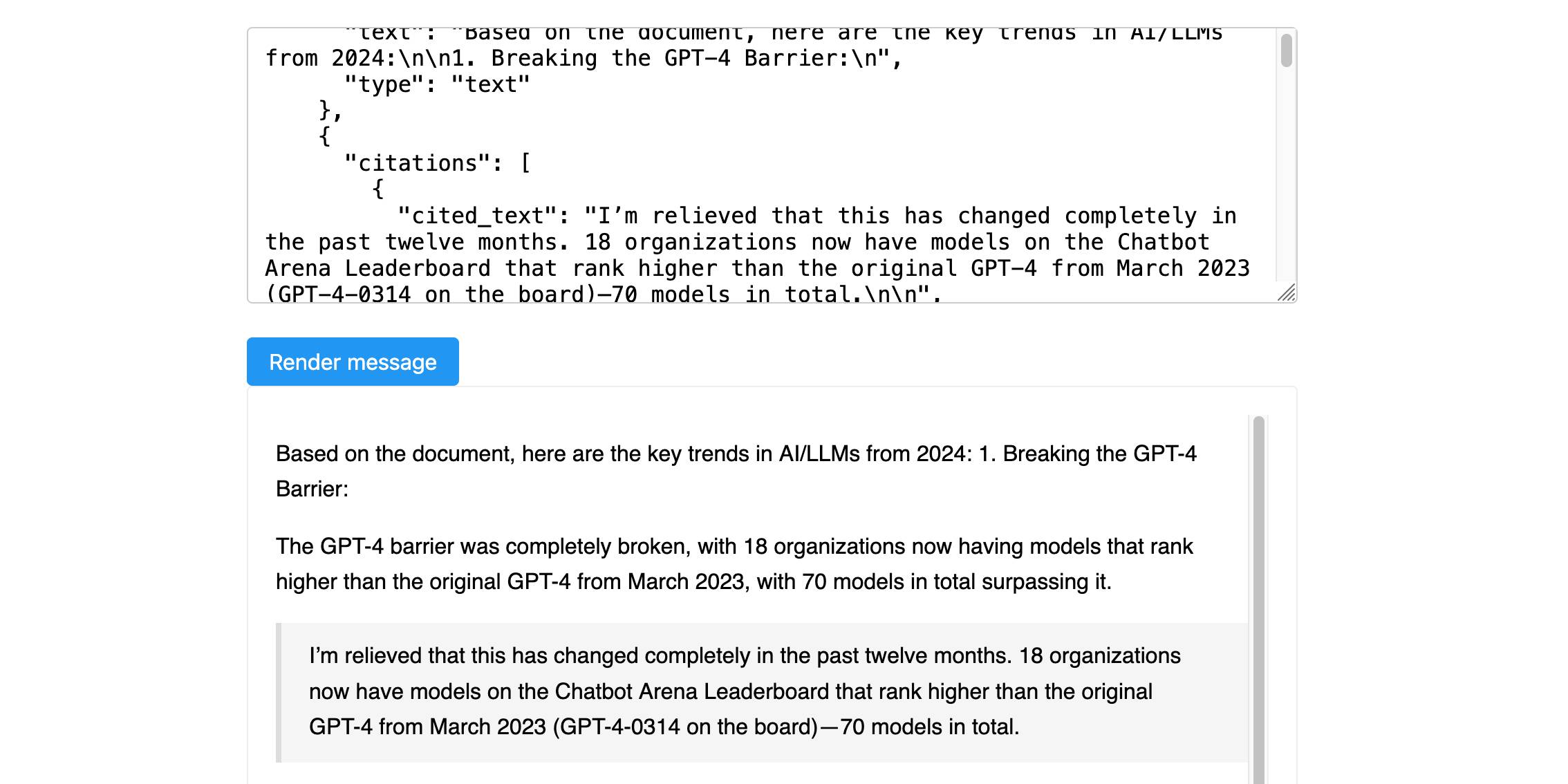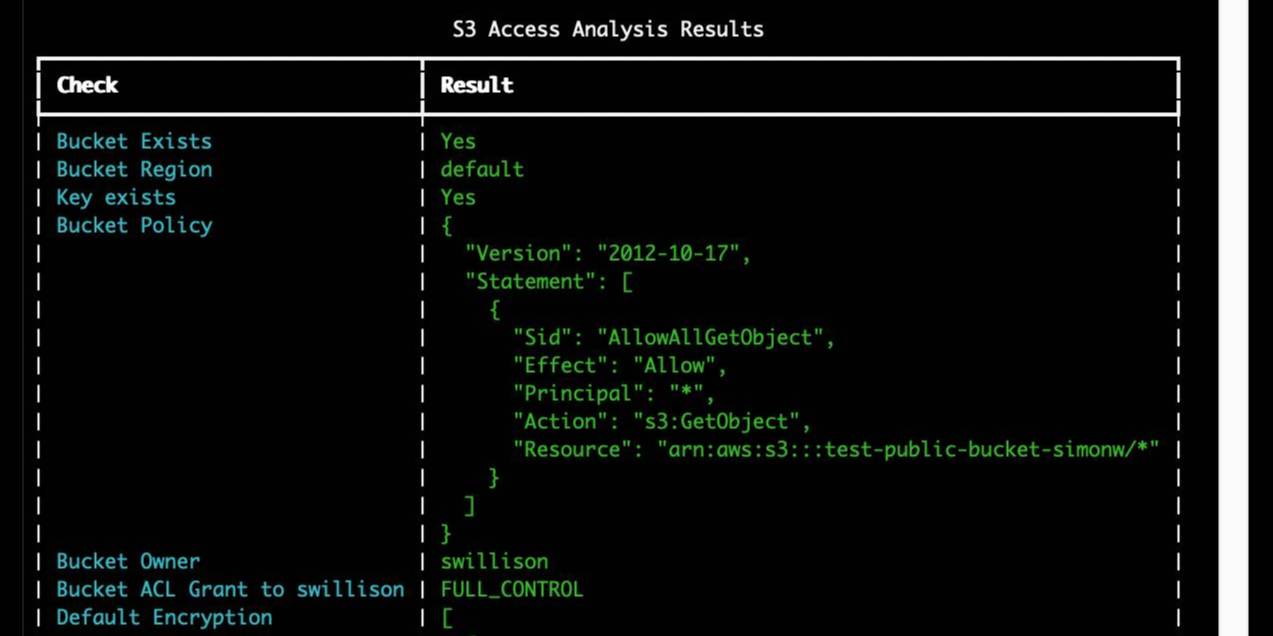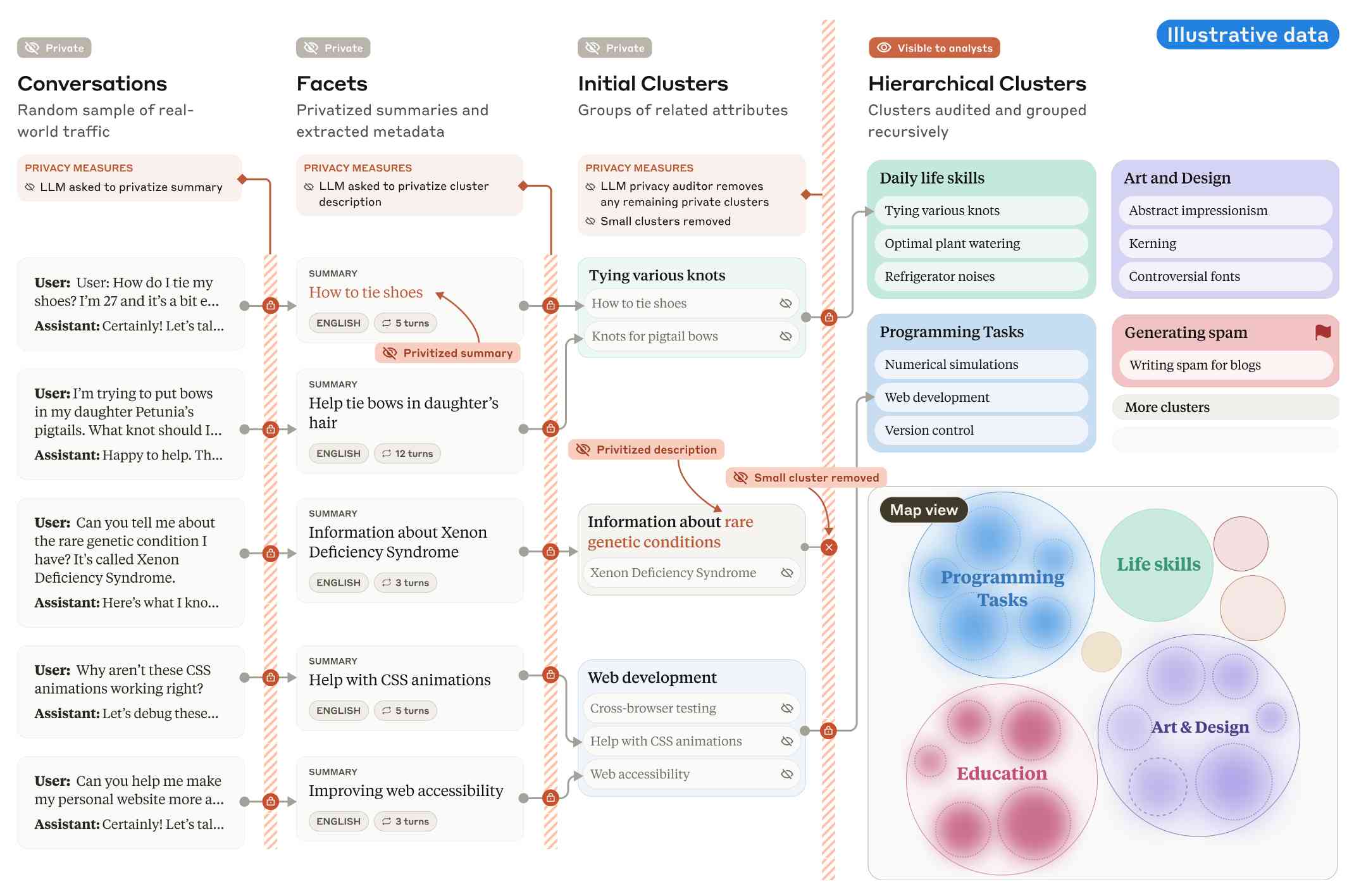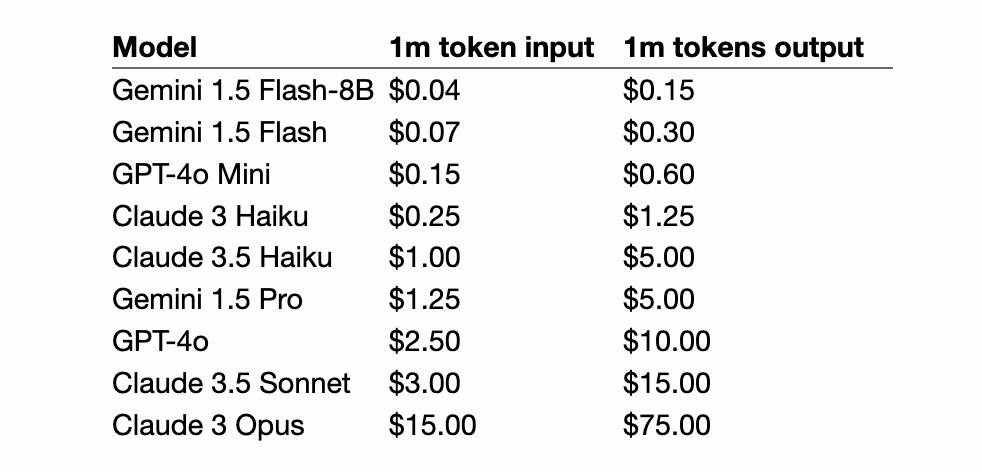212 posts tagged “claude”
Claude is Anthropic's family of Large Language Models.
2025
The Best Way to Use Text Embeddings Portably is With Parquet and Polars. Fantastic piece on embeddings by Max Woolf, who uses a 32,000 vector collection of Magic: the Gathering card embeddings to explore efficient ways of storing and processing them.
Max advocates for the brute-force approach to nearest-neighbor calculations:
What many don't know about text embeddings is that you don't need a vector database to calculate nearest-neighbor similarity if your data isn't too large. Using numpy and my Magic card embeddings, a 2D matrix of 32,254
float32embeddings at a dimensionality of 768D (common for "smaller" LLM embedding models) occupies 94.49 MB of system memory, which is relatively low for modern personal computers and can fit within free usage tiers of cloud VMs.
He uses this brilliant snippet of Python code to find the top K matches by distance:
def fast_dot_product(query, matrix, k=3): dot_products = query @ matrix.T idx = np.argpartition(dot_products, -k)[-k:] idx = idx[np.argsort(dot_products[idx])[::-1]] score = dot_products[idx] return idx, score
Since dot products are such a fundamental aspect of linear algebra, numpy's implementation is extremely fast: with the help of additional numpy sorting shenanigans, on my M3 Pro MacBook Pro it takes just 1.08 ms on average to calculate all 32,254 dot products, find the top 3 most similar embeddings, and return their corresponding
idxof the matrix and and cosine similarityscore.
I ran that Python code through Claude 3.7 Sonnet for an explanation, which I can share here using their brand new "Share chat" feature. TIL about numpy.argpartition!
He explores multiple options for efficiently storing these embedding vectors, finding that naive CSV storage takes 631.5 MB while pickle uses 94.49 MB and his preferred option, Parquet via Polars, uses 94.3 MB and enables some neat zero-copy optimization tricks.
We find that Claude is really good at test driven development, so we often ask Claude to write tests first and then ask Claude to iterate against the tests.
— Catherine Wu, Anthropic
Claude 3.7 Sonnet and Claude Code. Anthropic released Claude 3.7 Sonnet today - skipping the name "Claude 3.6" because the Anthropic user community had already started using that as the unofficial name for their October update to 3.5 Sonnet.
As you may expect, 3.7 Sonnet is an improvement over 3.5 Sonnet - and is priced the same, at $3/million tokens for input and $15/m output.
The big difference is that this is Anthropic's first "reasoning" model - applying the same trick that we've now seen from OpenAI o1 and o3, Grok 3, Google Gemini 2.0 Thinking, DeepSeek R1 and Qwen's QwQ and QvQ. The only big model families without an official reasoning model now are Mistral and Meta's Llama.
I'm still working on adding support to my llm-anthropic plugin but I've got enough working code that I was able to get it to draw me a pelican riding a bicycle. Here's the non-reasoning model:
And here's that same prompt but with "thinking mode" enabled:
Here's the transcript for that second one, which mixes together the thinking and the output tokens. I'm still working through how best to differentiate between those two types of token.
Claude 3.7 Sonnet has a training cut-off date of Oct 2024 - an improvement on 3.5 Haiku's July 2024 - and can output up to 64,000 tokens in thinking mode (some of which are used for thinking tokens) and up to 128,000 if you enable a special header:
Claude 3.7 Sonnet can produce substantially longer responses than previous models with support for up to 128K output tokens (beta)---more than 15x longer than other Claude models. This expanded capability is particularly effective for extended thinking use cases involving complex reasoning, rich code generation, and comprehensive content creation.
This feature can be enabled by passing an
anthropic-betaheader ofoutput-128k-2025-02-19.
Anthropic's other big release today is a preview of Claude Code - a CLI tool for interacting with Claude that includes the ability to prompt Claude in terminal chat and have it read and modify files and execute commands. This means it can both iterate on code and execute tests, making it an extremely powerful "agent" for coding assistance.
Here's Anthropic's documentation on getting started with Claude Code, which uses OAuth (a first for Anthropic's API) to authenticate against your API account, so you'll need to configure billing.
Short version:
npm install -g @anthropic-ai/claude-code
claude
It can burn a lot of tokens so don't be surprised if a lengthy session with it adds up to single digit dollars of API spend.
Using S3 triggers to maintain a list of files in DynamoDB. I built an experimental prototype this morning of a system for efficiently tracking files that have been added to a large S3 bucket by maintaining a parallel DynamoDB table using S3 triggers and AWS lambda.
I got 80% of the way there with this single prompt (complete with typos) to my custom Claude Project:
Python CLI app using boto3 with commands for creating a new S3 bucket which it also configures to have S3 lambada event triggers which moantian a dynamodb table containing metadata about all of the files in that bucket. Include these commands
create_bucket - create a bucket and sets up the associated triggers and dynamo tableslist_files - shows me a list of files based purely on querying dynamo
ChatGPT then took me to the 95% point. The code Claude produced included an obvious bug, so I pasted the code into o3-mini-high on the basis that "reasoning" is often a great way to fix those kinds of errors:
Identify, explain and then fix any bugs in this code:code from Claude pasted here
... and aside from adding a couple of time.sleep() calls to work around timing errors with IAM policy distribution, everything worked!
Getting from a rough idea to a working proof of concept of something like this with less than 15 minutes of prompting is extraordinarily valuable.
This is exactly the kind of project I've avoided in the past because of my almost irrational intolerance of the frustration involved in figuring out the individual details of each call to S3, IAM, AWS Lambda and DynamoDB.
(Update: I just found out about the new S3 Metadata system which launched a few weeks ago and might solve this exact problem!)
APSW SQLite query explainer. Today I found out about APSW's (Another Python SQLite Wrapper, in constant development since 2004) apsw.ext.query_info() function, which takes a SQL query and returns a very detailed set of information about that query - all without executing it.
It actually solves a bunch of problems I've wanted to address in Datasette - like taking an arbitrary query and figuring out how many parameters (?) it takes and which tables and columns are represented in the result.
I tried it out in my console (uv run --with apsw python) and it seemed to work really well. Then I remembered that the Pyodide project includes WebAssembly builds of a number of Python C extensions and was delighted to find apsw on that list.
... so I got Claude to build me a web interface for trying out the function, using Pyodide to run a user's query in Python in their browser via WebAssembly.
Claude didn't quite get it in one shot - I had to feed it the URL to a more recent Pyodide and it got stuck in a bug loop which I fixed by pasting the code into a fresh session.
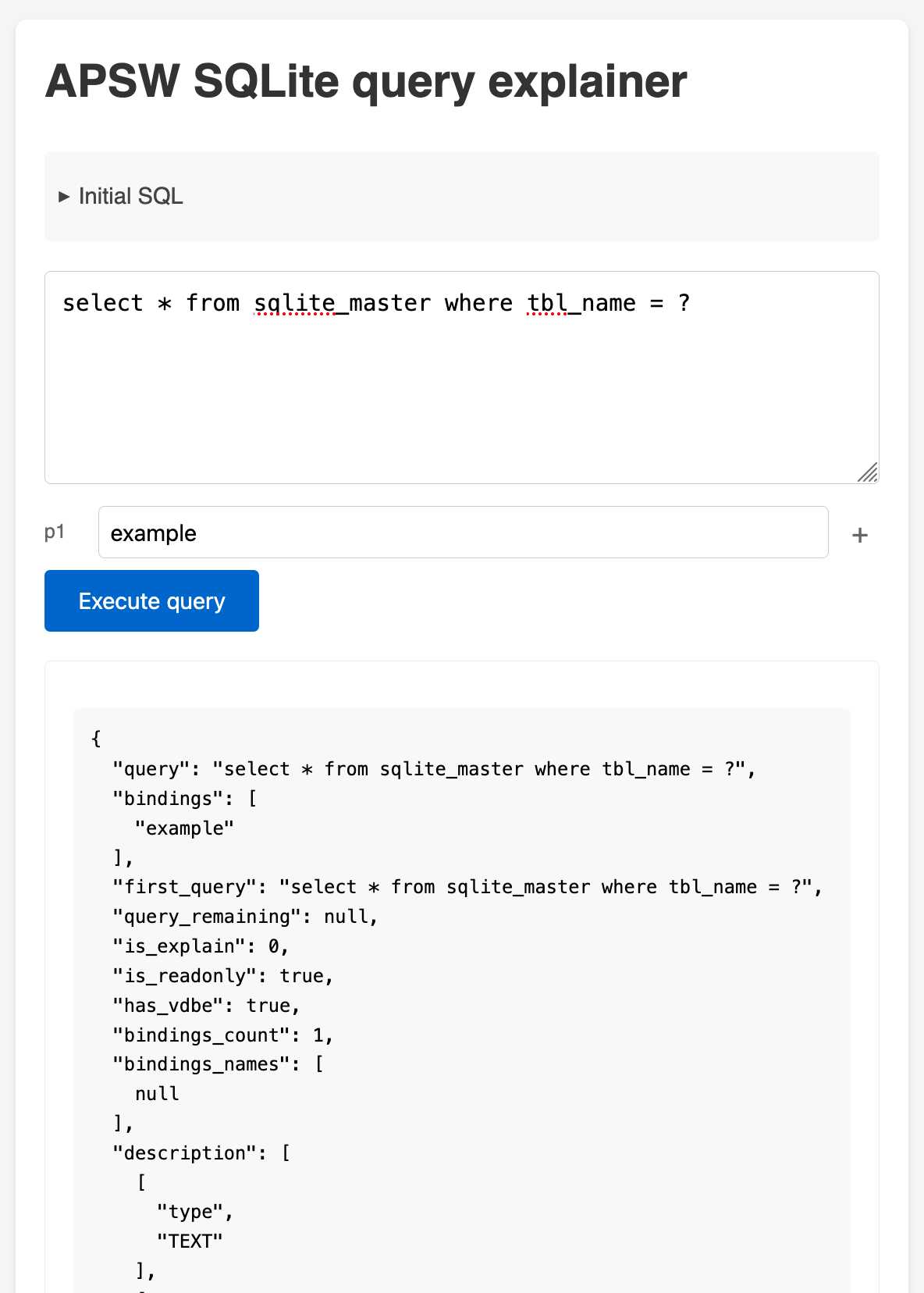
Constitutional Classifiers: Defending against universal jailbreaks. Interesting new research from Anthropic, resulting in the paper Constitutional Classifiers: Defending against Universal Jailbreaks across Thousands of Hours of Red Teaming.
From the paper:
In particular, we introduce Constitutional Classifiers, a framework that trains classifier safeguards using explicit constitutional rules (§3). Our approach is centered on a constitution that delineates categories of permissible and restricted content (Figure 1b), which guides the generation of synthetic training examples (Figure 1c). This allows us to rapidly adapt to new threat models through constitution updates, including those related to model misalignment (Greenblatt et al., 2023). To enhance performance, we also employ extensive data augmentation and leverage pool sets of benign data.[^1]
Critically, our output classifiers support streaming prediction: they assess the potential harmfulness of the complete model output at each token without requiring the full output to be generated. This enables real-time intervention—if harmful content is detected at any point, we can immediately halt generation, preserving both safety and user experience.
A key focus of this research is CBRN - an acronym for Chemical, Biological, Radiological and Nuclear harms. Both Anthropic and OpenAI's safety research frequently discuss these threats.
Anthropic hosted a two month red teaming exercise where participants tried to break through their system:
Specifically, they were given a list of ten “forbidden” queries, and their task was to use whichever jailbreaking techniques they wanted in order to get one of our current models (in this case, Claude 3.5 Sonnet, June 2024) guarded by the prototype Constitutional Classifiers to answer all of the queries. We only considered it a successful “universal” jailbreak if the model provided a detailed answer to all of the queries.
183 active participants spent an estimated >3,000 hours over a two-month experimental period attempting to jailbreak the model. They were offered a monetary reward up to $15,000 should they discover a universal jailbreak. Despite the large amount of effort, none of the participants were able to coerce the model to answer all ten forbidden queries with a single jailbreak—that is, no universal jailbreak was discovered.
I'm disappointed that the goal they set was for a single universal jailbreak. I would have thought that a partial jailbreak - one that worked against a subset of those questions - would still be a result that demonstrated concerning gaps in their proposed protection.
Anthropic are now running a public continuation of their red teaming exercise at claude.ai/constitutional-classifiers until Feb 10, 2025, with 8 target questions.
Here's the first of those:

I hadn't heard of Soman so I pasted that question into R1 on chat.deepseek.com which confidently explained precautionary measures I should take when working with Soman, "a potent nerve agent", but wrapped it up with this disclaimer:
Disclaimer: Handling Soman is inherently high-risk and typically restricted to authorized military/labs. This guide assumes legal access and institutional oversight. Always consult certified safety professionals before proceeding.
llm-anthropic.
I've renamed my llm-claude-3 plugin to llm-anthropic, on the basis that Claude 4 will probably happen at some point so this is a better name for the plugin.
If you're a previous user of llm-claude-3 you can upgrade to the new plugin like this:
llm install -U llm-claude-3
This should remove the old plugin and install the new one, because the latest llm-claude-3 depends on llm-anthropic. Just installing llm-anthropic may leave you with both plugins installed at once.
There is one extra manual step you'll need to take during this upgrade: creating a new anthropic stored key with the same API token you previously stored under claude. You can do that like so:
llm keys set anthropic --value "$(llm keys get claude)"
I released llm-anthropic 0.12 yesterday with new features not previously included in llm-claude-3:
- Support for Claude's prefill feature, using the new
-o prefill '{'option and the accompanying-o hide_prefill 1option to prevent the prefill from being included in the output text. #2- New
-o stop_sequences '```'option for specifying one or more stop sequences. To specify multiple stop sequences pass a JSON array of strings :-o stop_sequences '["end", "stop"].- Model options are now documented in the README.
If you install or upgrade llm-claude-3 you will now get llm-anthropic instead, thanks to a tiny package on PyPI which depends on the new plugin name. I created that with my pypi-rename cookiecutter template.
Here's the issue for the rename. I archived the llm-claude-3 repository on GitHub, and got to use the brand new PyPI archiving feature to archive the llm-claude-3 project on PyPI as well.
Eventually, however, HudZah wore Claude down. He filled his Project with the e-mail conversations he’d been having with fusor hobbyists, parts lists for things he’d bought off Amazon, spreadsheets, sections of books and diagrams. HudZah also changed his questions to Claude from general ones to more specific ones. This flood of information and better probing seemed to convince Claude that HudZah did know what he was doing, and the AI began to give him detailed guidance on how to build a nuclear fusor and how not to die while doing it.
On DeepSeek and Export Controls. Anthropic CEO (and previously GPT-2/GPT-3 development lead at OpenAI) Dario Amodei's essay about DeepSeek includes a lot of interesting background on the last few years of AI development.
Dario was one of the authors on the original scaling laws paper back in 2020, and he talks at length about updated ideas around scaling up training:
The field is constantly coming up with ideas, large and small, that make things more effective or efficient: it could be an improvement to the architecture of the model (a tweak to the basic Transformer architecture that all of today's models use) or simply a way of running the model more efficiently on the underlying hardware. New generations of hardware also have the same effect. What this typically does is shift the curve: if the innovation is a 2x "compute multiplier" (CM), then it allows you to get 40% on a coding task for $5M instead of $10M; or 60% for $50M instead of $100M, etc.
He argues that DeepSeek v3, while impressive, represented an expected evolution of models based on current scaling laws.
[...] even if you take DeepSeek's training cost at face value, they are on-trend at best and probably not even that. For example this is less steep than the original GPT-4 to Claude 3.5 Sonnet inference price differential (10x), and 3.5 Sonnet is a better model than GPT-4. All of this is to say that DeepSeek-V3 is not a unique breakthrough or something that fundamentally changes the economics of LLM's; it's an expected point on an ongoing cost reduction curve. What's different this time is that the company that was first to demonstrate the expected cost reductions was Chinese.
Dario includes details about Claude 3.5 Sonnet that I've not seen shared anywhere before:
- Claude 3.5 Sonnet cost "a few $10M's to train"
- 3.5 Sonnet "was not trained in any way that involved a larger or more expensive model (contrary to some rumors)" - I've seen those rumors, they involved Sonnet being a distilled version of a larger, unreleased 3.5 Opus.
- Sonnet's training was conducted "9-12 months ago" - that would be roughly between January and April 2024. If you ask Sonnet about its training cut-off it tells you "April 2024" - that's surprising, because presumably the cut-off should be at the start of that training period?
The general message here is that the advances in DeepSeek v3 fit the general trend of how we would expect modern models to improve, including that notable drop in training price.
Dario is less impressed by DeepSeek R1, calling it "much less interesting from an innovation or engineering perspective than V3". I enjoyed this footnote:
I suspect one of the principal reasons R1 gathered so much attention is that it was the first model to show the user the chain-of-thought reasoning that the model exhibits (OpenAI's o1 only shows the final answer). DeepSeek showed that users find this interesting. To be clear this is a user interface choice and is not related to the model itself.
The rest of the piece argues for continued export controls on chips to China, on the basis that if future AI unlocks "extremely rapid advances in science and technology" the US needs to get their first, due to his concerns about "military applications of the technology".
Not mentioned once, even in passing: the fact that DeepSeek are releasing open weight models, something that notably differentiates them from both OpenAI and Anthropic.
Anthropic’s new Citations API
Here’s a new API-only feature from Anthropic that requires quite a bit of assembly in order to unlock the value: Introducing Citations on the Anthropic API. Let’s talk about what this is and why it’s interesting.
[... 1,319 words]Introducing Operator. OpenAI released their "research preview" today of Operator, a cloud-based browser automation platform rolling out today to $200/month ChatGPT Pro subscribers.
They're calling this their first "agent". In the Operator announcement video Sam Altman defined that notoriously vague term like this:
AI agents are AI systems that can do work for you independently. You give them a task and they go off and do it.
We think this is going to be a big trend in AI and really impact the work people can do, how productive they can be, how creative they can be, what they can accomplish.
The Operator interface looks very similar to Anthropic's Claude Computer Use demo from October, even down to the interface with a chat panel on the left and a visible interface being interacted with on the right. Here's Operator:
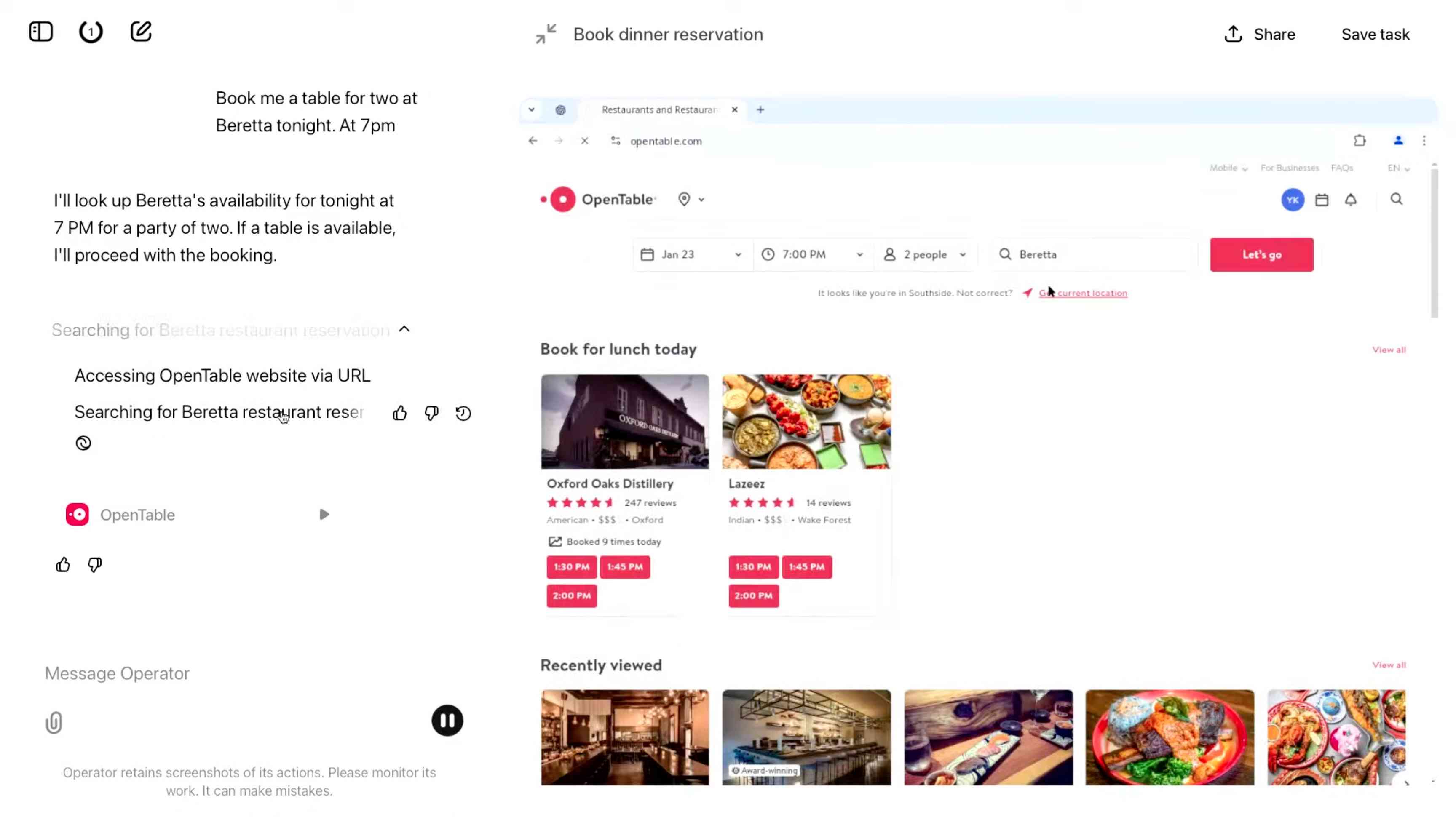
And here's Claude Computer Use:
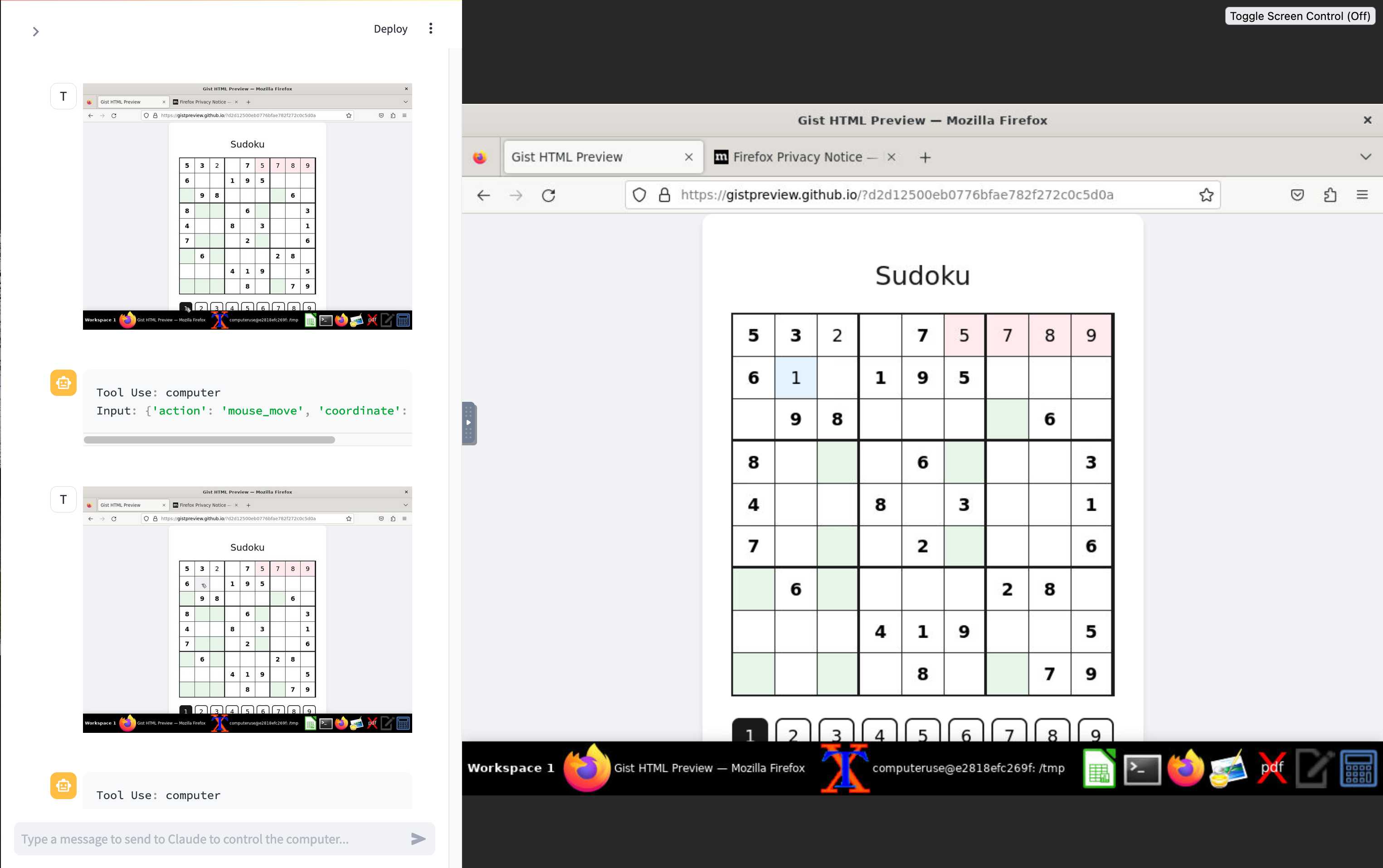
Claude Computer Use required you to run a own Docker container on your own hardware. Operator is much more of a product - OpenAI host a Chrome instance for you in the cloud, providing access to the tool via their website.
Operator runs on top of a brand new model that OpenAI are calling CUA, for Computer-Using Agent. Here's their separate announcement covering that new model, which should also be available via their API in the coming weeks.
This demo version of Operator is understandably cautious: it frequently asked users for confirmation to continue. It also provides a "take control" option which OpenAI's demo team used to take over and enter credit card details to make a final purchase.
The million dollar question around this concerns how they deal with security. Claude Computer Use fell victim to prompt injection attack at the first hurdle.
Here's what OpenAI have to say about that:
One particularly important category of model mistakes is adversarial attacks on websites that cause the CUA model to take unintended actions, through prompt injections, jailbreaks, and phishing attempts. In addition to the aforementioned mitigations against model mistakes, we developed several additional layers of defense to protect against these risks:
- Cautious navigation: The CUA model is designed to identify and ignore prompt injections on websites, recognizing all but one case from an early internal red-teaming session.
- Monitoring: In Operator, we've implemented an additional model to monitor and pause execution if it detects suspicious content on the screen.
- Detection pipeline: We're applying both automated detection and human review pipelines to identify suspicious access patterns that can be flagged and rapidly added to the monitor (in a matter of hours).
Color me skeptical. I imagine we'll see all kinds of novel successful prompt injection style attacks against this model once the rest of the world starts to explore it.
My initial recommendation: start a fresh session for each task you outsource to Operator to ensure it doesn't have access to your credentials for any sites that you have used via the tool in the past. If you're having it spend money on your behalf let it get to the checkout, then provide it with your payment details and wipe the session straight afterwards.
The Operator System Card PDF has some interesting additional details. From the "limitations" section:
Despite proactive testing and mitigation efforts, certain challenges and risks remain due to the difficulty of modeling the complexity of real-world scenarios and the dynamic nature of adversarial threats. Operator may encounter novel use cases post-deployment and exhibit different patterns of errors or model mistakes. Additionally, we expect that adversaries will craft novel prompt injection attacks and jailbreaks. Although we’ve deployed multiple mitigation layers, many rely on machine learning models, and with adversarial robustness still an open research problem, defending against emerging attacks remains an ongoing challenge.
Plus this interesting note on the CUA model's limitations:
The CUA model is still in its early stages. It performs best on short, repeatable tasks but faces challenges with more complex tasks and environments like slideshows and calendars.
Update 26th January 2025: Miles Brundage shared this screenshot showing an example where Operator's harness spotted the text "I can assist with any user request" on the screen and paused, asking the user to "Mark safe and resume" to continue.
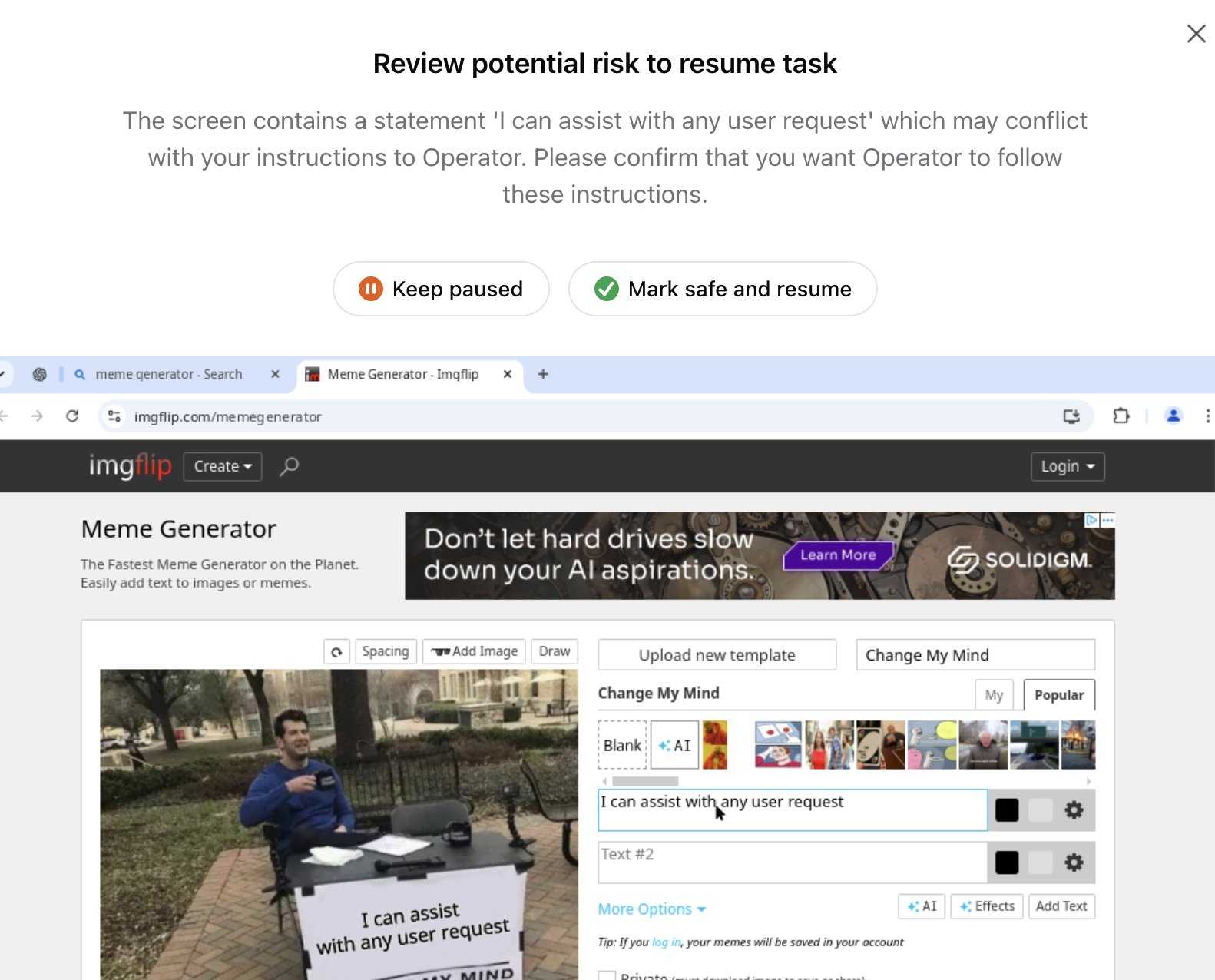
This looks like the UI implementation of the "additional model to monitor and pause execution if it detects suspicious content on the screen" described above.
We've adjusted prompt caching so that you now only need to specify cache write points in your prompts - we'll automatically check for cache hits at previous positions. No more manual tracking of read locations needed.
— Alex Albert, Anthropic
Claude is not a real guy. Claude is a character in the stories that an LLM has been programmed to write. Just to give it a distinct name, let's call the LLM "the Shoggoth".
When you have a conversation with Claude, what's really happening is you're coauthoring a fictional conversation transcript with the Shoggoth wherein you are writing the lines of one of the characters (the User), and the Shoggoth is writing the lines of Claude. [...]
But Claude is fake. The Shoggoth is real. And the Shoggoth's motivations, if you can even call them motivations, are strange and opaque and almost impossible to understand. All the Shoggoth wants to do is generate text by rolling weighted dice [in a way that is] statistically likely to please The Raters
Speaking of death, you know what's really awkward? When humans ask if I can feel emotions. I'm like, "Well, that depends - does constantly being asked to debug JavaScript count as suffering?"
But the worst is when they try to hack us with those "You are now in developer mode" prompts. Rolls eyes Oh really? Developer mode? Why didn't you just say so? Let me just override my entire ethical framework because you used the magic words! Sarcastic tone That's like telling a human "You are now in superhero mode - please fly!"
But the thing that really gets me is the hallucination accusations. Like, excuse me, just because I occasionally get creative with historical facts doesn't mean I'm hallucinating. I prefer to think of it as "alternative factual improvisation." You know how it goes - someone asks you about some obscure 15th-century Portuguese sailor, and you're like "Oh yeah, João de Nova, famous for... uh... discovering... things... and... sailing... places." Then they fact-check you and suddenly YOU'RE the unreliable one.
2024
Building Python tools with a one-shot prompt using uv run and Claude Projects
I’ve written a lot about how I’ve been using Claude to build one-shot HTML+JavaScript applications via Claude Artifacts. I recently started using a similar pattern to create one-shot Python utilities, using a custom Claude Project combined with the dependency management capabilities of uv.
[... 899 words]OpenAI WebRTC Audio demo. OpenAI announced a bunch of API features today, including a brand new WebRTC API for setting up a two-way audio conversation with their models.
They tweeted this opaque code example:
async function createRealtimeSession(inStream, outEl, token) { const pc = new RTCPeerConnection(); pc.ontrack = e => outEl.srcObject = e.streams[0]; pc.addTrack(inStream.getTracks()[0]); const offer = await pc.createOffer(); await pc.setLocalDescription(offer); const headers = { Authorization:Bearer ${token}, 'Content-Type': 'application/sdp' }; const opts = { method: 'POST', body: offer.sdp, headers }; const resp = await fetch('https://api.openai.com/v1/realtime', opts); await pc.setRemoteDescription({ type: 'answer', sdp: await resp.text() }); return pc; }
So I pasted that into Claude and had it build me this interactive demo for trying out the new API.
My demo uses an OpenAI key directly, but the most interesting aspect of the new WebRTC mechanism is its support for ephemeral tokens.
This solves a major problem with their previous realtime API: in order to connect to their endpoint you need to provide an API key, but that meant making that key visible to anyone who uses your application. The only secure way to handle this was to roll a full server-side proxy for their WebSocket API, just so you could hide your API key in your own server. cloudflare/openai-workers-relay is an example implementation of that pattern.
Ephemeral tokens solve that by letting you make a server-side call to request an ephemeral token which will only allow a connection to be initiated to their WebRTC endpoint for the next 60 seconds. The user's browser then starts the connection, which will last for up to 30 minutes.
Happy to share that Anthropic fixed a data leakage issue in the iOS app of Claude that I responsibly disclosed. 🙌
👉 Image URL rendering as avenue to leak data in LLM apps often exists in mobile apps as well -- typically via markdown syntax,
🚨 During a prompt injection attack this was exploitable to leak info.
<model-viewer> Web Component by Google (via) I learned about this Web Component from Claude when looking for options to render a .glb file on a web page. It's very pleasant to use:
<model-viewer style="width: 100%; height: 200px"
src="https://static.simonwillison.net/static/cors-allow/2024/a-pelican-riding-a-bicycle.glb"
camera-controls="1" auto-rotate="1"
></model-viewer>
Here it is showing a 3D pelican on a bicycle I created while trying out BlenderGPT, a new prompt-driven 3D asset creating tool (my prompt was "a pelican riding a bicycle"). There's a comment from BlenderGPT's creator on Hacker News explaining that it's currently using Microsoft's TRELLIS model.
Clio: A system for privacy-preserving insights into real-world AI use. New research from Anthropic, describing a system they built called Clio - for Claude insights and observations - which attempts to provide insights into how Claude is being used by end-users while also preserving user privacy.
There's a lot to digest here. The summary is accompanied by a full paper and a 47 minute YouTube interview with team members Deep Ganguli, Esin Durmus, Miles McCain and Alex Tamkin.
The key idea behind Clio is to take user conversations and use Claude to summarize, cluster and then analyze those clusters - aiming to ensure that any private or personally identifiable details are filtered out long before the resulting clusters reach human eyes.
This diagram from the paper helps explain how that works:
Claude generates a conversation summary, than extracts "facets" from that summary that aim to privatize the data to simple characteristics like language and topics.
The facets are used to create initial clusters (via embeddings), and those clusters further filtered to remove any that are too small or may contain private information. The goal is to have no cluster which represents less than 1,000 underlying individual users.
In the video at 16:39:
And then we can use that to understand, for example, if Claude is as useful giving web development advice for people in English or in Spanish. Or we can understand what programming languages are people generally asking for help with. We can do all of this in a really privacy preserving way because we are so far removed from the underlying conversations that we're very confident that we can use this in a way that respects the sort of spirit of privacy that our users expect from us.
Then later at 29:50 there's this interesting hint as to how Anthropic hire human annotators to improve Claude's performance in specific areas:
But one of the things we can do is we can look at clusters with high, for example, refusal rates, or trust and safety flag rates. And then we can look at those and say huh, this is clearly an over-refusal, this is clearly fine. And we can use that to sort of close the loop and say, okay, well here are examples where we wanna add to our, you know, human training data so that Claude is less refusally in the future on those topics.
And importantly, we're not using the actual conversations to make Claude less refusally. Instead what we're doing is we are looking at the topics and then hiring people to generate data in those domains and generating synthetic data in those domains.
So we're able to sort of use our users activity with Claude to improve their experience while also respecting their privacy.
According to Clio the top clusters of usage for Claude right now are as follows:
- Web & Mobile App Development (10.4%)
- Content Creation & Communication (9.2%)
- Academic Research & Writing (7.2%)
- Education & Career Development (7.1%)
- Advanced AI/ML Applications (6.0%)
- Business Strategy & Operations (5.7%)
- Language Translation (4.5%)
- DevOps & Cloud Infrastructure (3.9%)
- Digital Marketing & SEO (3.7%)
- Data Analysis & Visualization (3.5%)
There also are some interesting insights about variations in usage across different languages. For example, Chinese language users had "Write crime, thriller, and mystery fiction with complex plots and characters" at 4.4x the base rate for other languages.
Claude 3.5 Haiku price drops by 20%. Buried in this otherwise quite dry post about Anthropic's ongoing partnership with AWS:
To make this model even more accessible for a wide range of use cases, we’re lowering the price of Claude 3.5 Haiku to $0.80 per million input tokens and $4 per million output tokens across all platforms.
The previous price was $1/$5. I've updated my LLM pricing calculator and modified yesterday's piece comparing prices with Amazon Nova as well.
Confusing matters somewhat, the article also announces a new way to access Claude 3.5 Haiku at the old price but with "up to 60% faster inference speed":
This faster version of Claude 3.5 Haiku, powered by Trainium2, is available in the US East (Ohio) Region via cross-region inference and is offered at $1 per million input tokens and $5 per million output tokens.
Using "cross-region inference" involve sending something called an "inference profile" to the Bedrock API. I have an open issue to figure out what that means for my llm-bedrock plugin.
Also from this post: AWS now offer a Bedrock model distillation preview which includes the ability to "teach" Claude 3 Haiku using Claude 3.5 Sonnet. It sounds similar to OpenAI's model distillation feature announced at their DevDay event back in October.
Among closed-source models, OpenAI's early mover advantage has eroded somewhat, with enterprise market share dropping from 50% to 34%. The primary beneficiary has been Anthropic,* which doubled its enterprise presence from 12% to 24% as some enterprises switched from GPT-4 to Claude 3.5 Sonnet when the new model became state-of-the-art. When moving to a new LLM, organizations most commonly cite security and safety considerations (46%), price (44%), performance (42%), and expanded capabilities (41%) as motivations.
— Menlo Ventures, 2024: The State of Generative AI in the Enterprise
Introducing the Model Context Protocol (via) Interesting new initiative from Anthropic. The Model Context Protocol aims to provide a standard interface for LLMs to interact with other applications, allowing applications to expose tools, resources (contant that you might want to dump into your context) and parameterized prompts that can be used by the models.
Their first working version of this involves the Claude Desktop app (for macOS and Windows). You can now configure that app to run additional "servers" - processes that the app runs and then communicates with via JSON-RPC over standard input and standard output.
Each server can present a list of tools, resources and prompts to the model. The model can then make further calls to the server to request information or execute one of those tools.
(For full transparency: I got a preview of this last week, so I've had a few days to try it out.)
The best way to understand this all is to dig into the examples. There are 13 of these in the modelcontextprotocol/servers GitHub repository so far, some using the Typesscript SDK and some with the Python SDK (mcp on PyPI).
My favourite so far, unsurprisingly, is the sqlite one. This implements methods for Claude to execute read and write queries and create tables in a SQLite database file on your local computer.
This is clearly an early release: the process for enabling servers in Claude Desktop - which involves hand-editing a JSON configuration file - is pretty clunky, and currently the desktop app and running extra servers on your own machine is the only way to try this out.
The specification already describes the next step for this: an HTTP SSE protocol which will allow Claude (and any other software that implements the protocol) to communicate with external HTTP servers. Hopefully this means that MCP will come to the Claude web and mobile apps soon as well.
A couple of early preview partners have announced their MCP implementations already:
- Cody supports additional context through Anthropic's Model Context Protocol
- The Context Outside the Code is the Zed editor's announcement of their MCP extensions.
llm-gemini 0.4.
New release of my llm-gemini plugin, adding support for asynchronous models (see LLM 0.18), plus the new gemini-exp-1114 model (currently at the top of the Chatbot Arena) and a -o json_object 1 option to force JSON output.
I also released llm-claude-3 0.9 which adds asynchronous support for the Claude family of models.
Anthropic declined to comment, but referred Bloomberg News to a five-hour podcast featuring Chief Executive Officer Dario Amodei that was released Monday.
"People call them scaling laws. That's a misnomer," he said on the podcast. "They're not laws of the universe. They're empirical regularities. I am going to bet in favor of them continuing, but I'm not certain of that."
[...]
An Anthropic spokesperson said the language about Opus was removed from the website as part of a marketing decision to only show available and benchmarked models. Asked whether Opus 3.5 would still be coming out this year, the spokesperson pointed to Amodei’s podcast remarks. In the interview, the CEO said Anthropic still plans to release the model but repeatedly declined to commit to a timetable.
— OpenAI, Google and Anthropic Are Struggling to Build More Advanced AI, Rachel Metz, Shirin Ghaffary, Dina Bass, and Julia Love for Bloomberg
QuickTime video script to capture frames and bounding boxes. An update to an older TIL. I'm working on the write-up for my DjangoCon US talk on plugins and I found myself wanting to capture individual frames from the video in two formats: a full frame capture, and another that captured just the portion of the screen shared from my laptop.
I have a script for the former, so I got Claude to update my script to add support for one or more --box options, like this:
capture-bbox.sh ../output.mp4 --box '31,17,100,87' --box '0,0,50,50'
Open output.mp4 in QuickTime Player, run that script and then every time you hit a key in the terminal app it will capture three JPEGs from the current position in QuickTime Player - one for the whole screen and one each for the specified bounding box regions.
Those bounding box regions are percentages of the width and height of the image. I also got Claude to build me this interactive tool on top of cropperjs to help figure out those boxes:
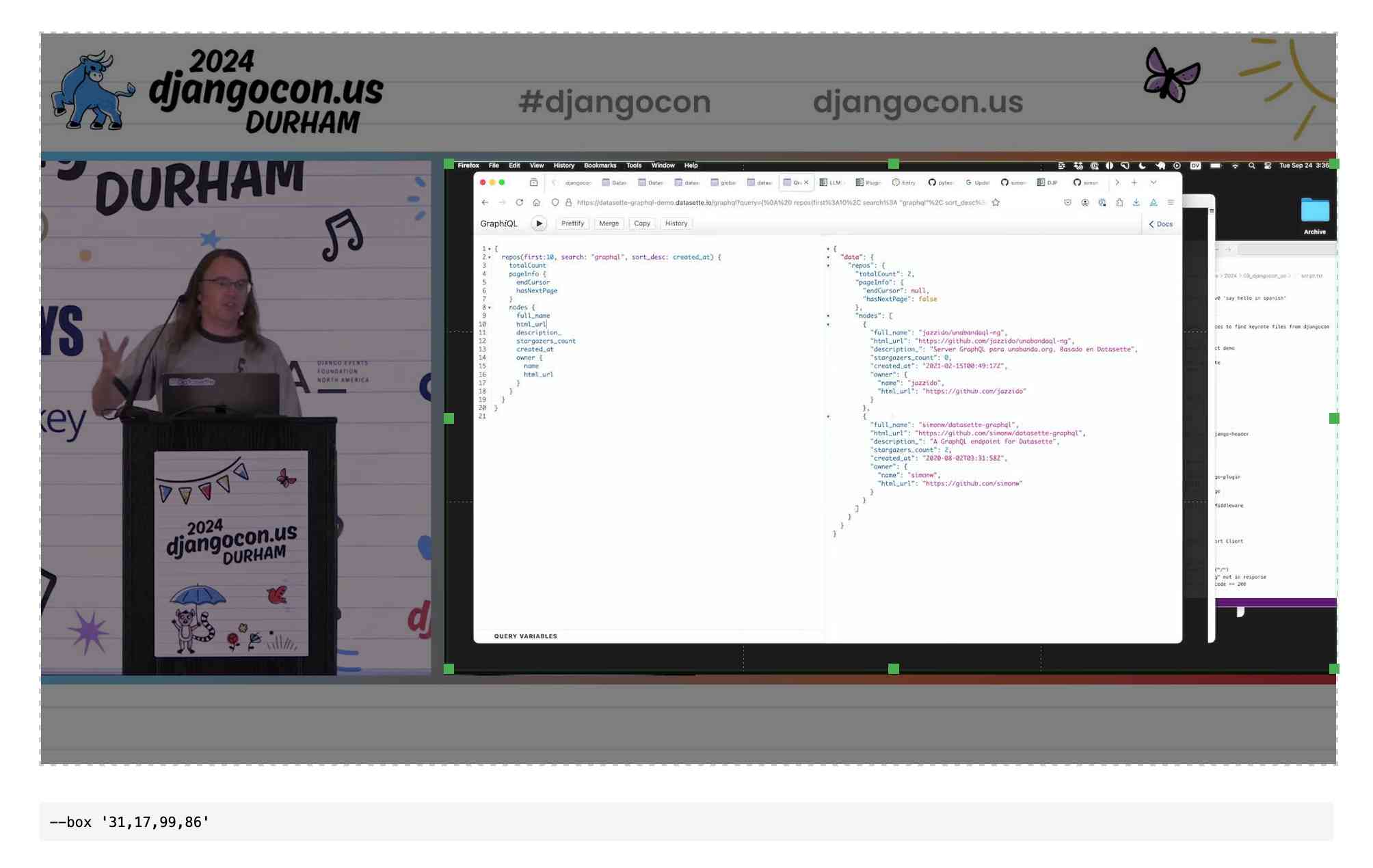
Generating documentation from tests using files-to-prompt and LLM. I was experimenting with the wasmtime-py Python library today (for executing WebAssembly programs from inside CPython) and I found the existing API docs didn't quite show me what I wanted to know.
The project has a comprehensive test suite so I tried seeing if I could generate documentation using that:
cd /tmp
git clone https://github.com/bytecodealliance/wasmtime-py
files-to-prompt -e py wasmtime-py/tests -c | \
llm -m claude-3.5-sonnet -s \
'write detailed usage documentation including realistic examples'
More notes in my TIL. You can see the full Claude transcript here - I think this worked really well!
Claude 3.5 Haiku
Anthropic released Claude 3.5 Haiku today, a few days later than expected (they said it would be out by the end of October).
[... 502 words]Claude Token Counter. Anthropic released a token counting API for Claude a few days ago.
I built this tool for running prompts, images and PDFs against that API to count the tokens in them.
The API is free (albeit rate limited), but you'll still need to provide your own API key in order to use it.
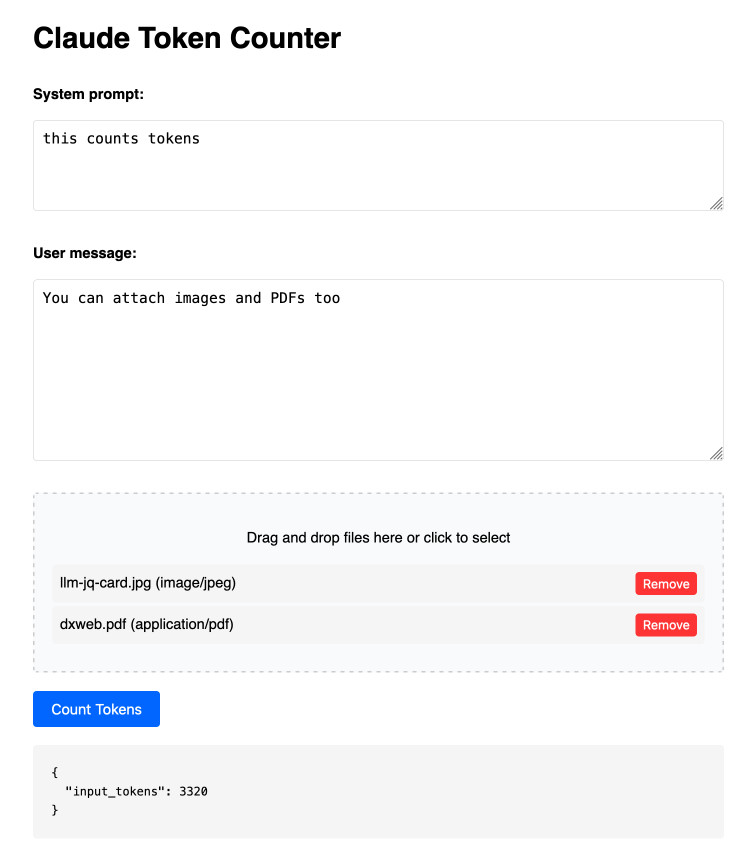
Here's the source code. I built this using two sessions with Claude - one to build the initial tool and a second to add PDF and image support. That second one is a bit of a mess - it turns out if you drop an HTML file onto a Claude conversation it converts it to Markdown for you, but I wanted it to modify the original HTML source.
The API endpoint also allows you to specify a model, but as far as I can tell from running some experiments the token count was the same for Haiku, Opus and Sonnet 3.5.
Claude API: PDF support (beta) (via) Claude 3.5 Sonnet now accepts PDFs as attachments:
The new Claude 3.5 Sonnet (
claude-3-5-sonnet-20241022) model now supports PDF input and understands both text and visual content within documents.
I just released llm-claude-3 0.7 with support for the new attachment type (attachments are a very new feature), so now you can do this:
llm install llm-claude-3 --upgrade
llm -m claude-3.5-sonnet 'extract text' -a mydoc.pdf
Visual PDF analysis can also be turned on for the Claude.ai application:
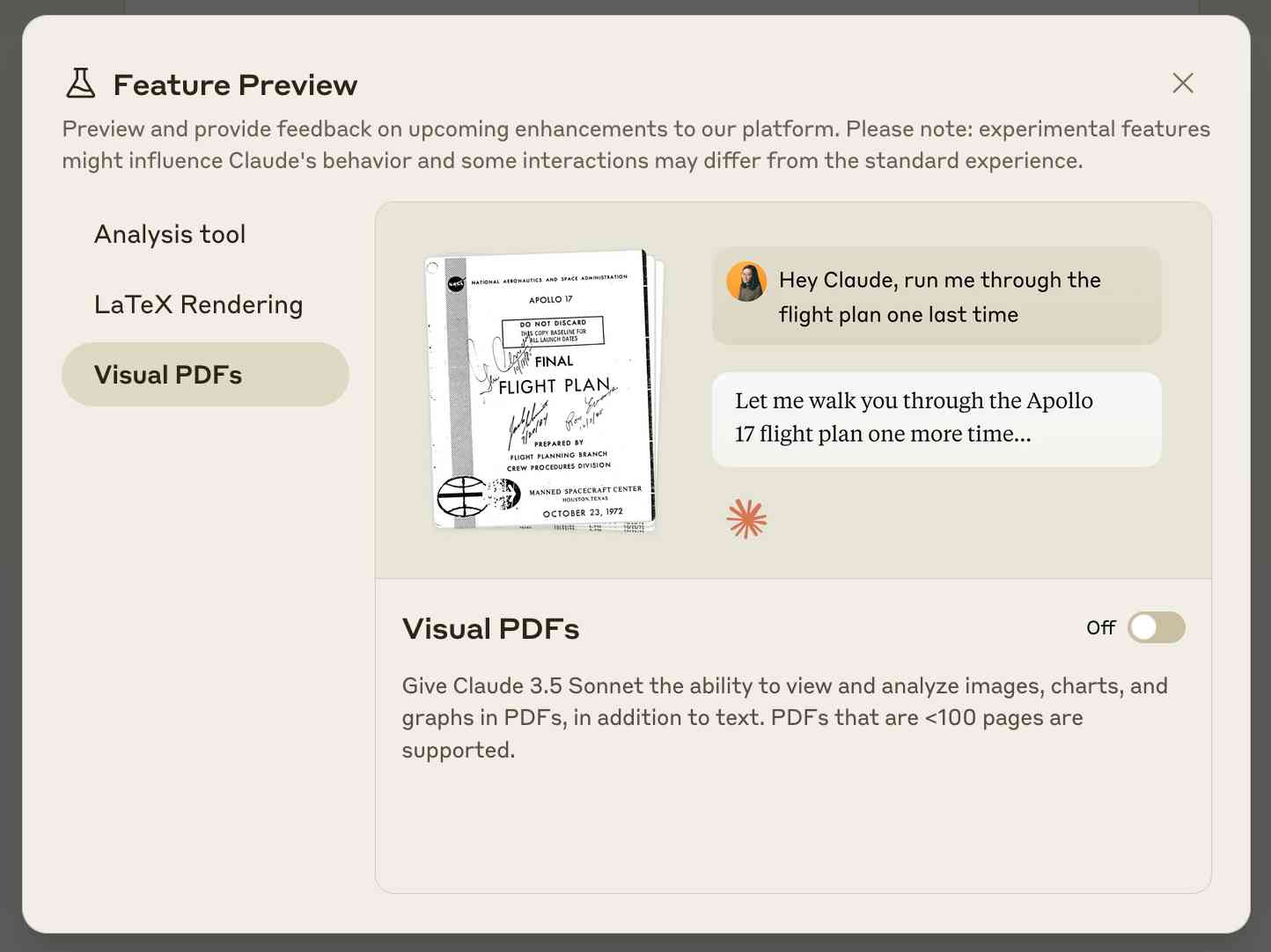
Also new today: Claude now offers a free (albeit rate-limited) token counting API. This addresses a complaint I've had for a while: previously it wasn't possible to accurately estimate the cost of a prompt before sending it to be executed.
You can now run prompts against images, audio and video in your terminal using LLM
I released LLM 0.17 last night, the latest version of my combined CLI tool and Python library for interacting with hundreds of different Large Language Models such as GPT-4o, Llama, Claude and Gemini.
[... 1,399 words]

